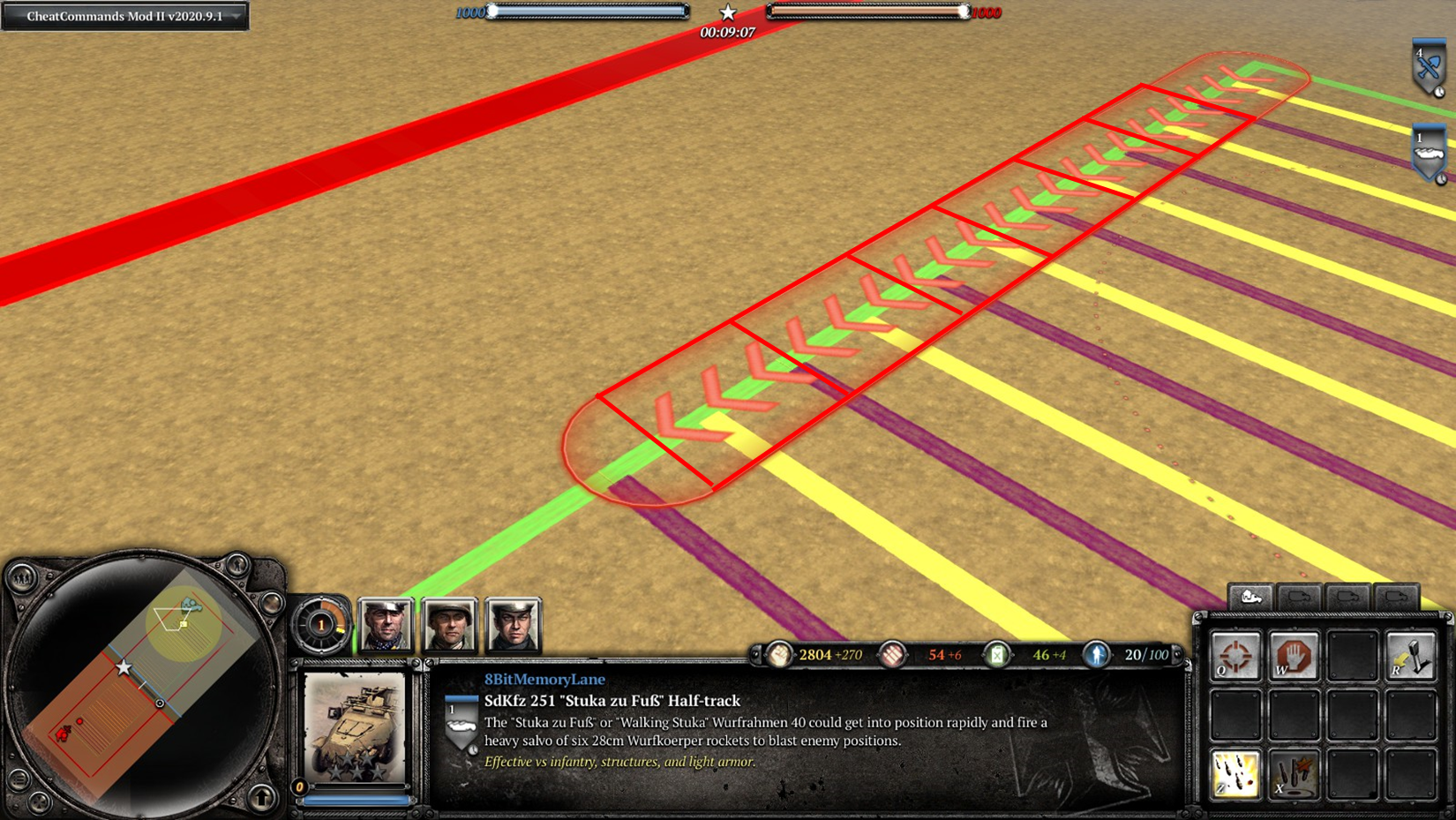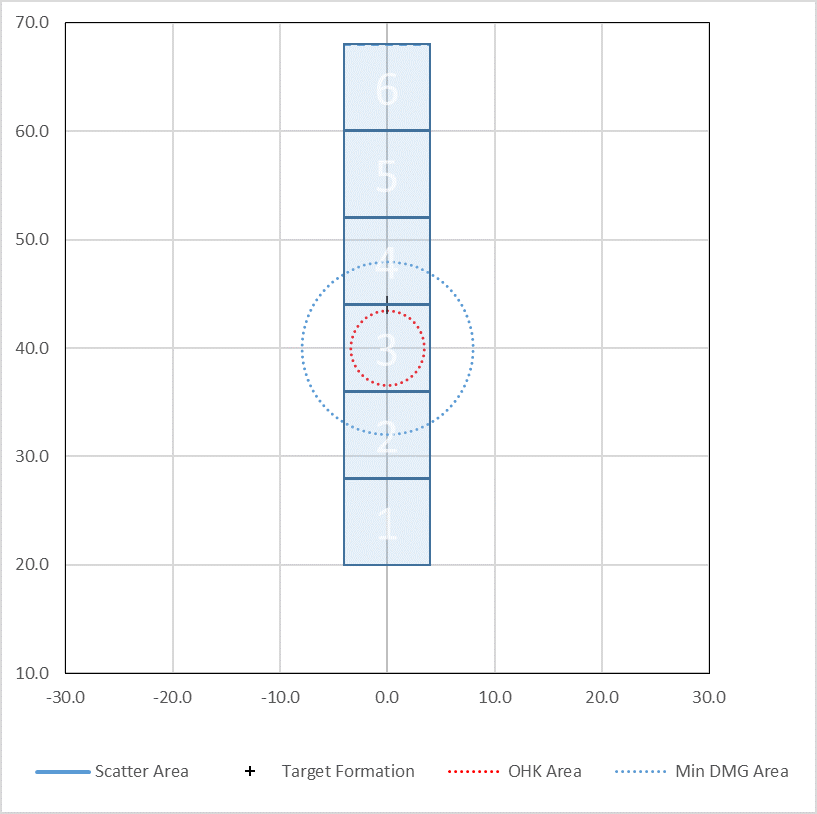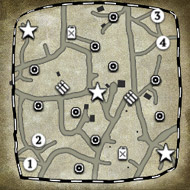|
still not sure what exactly the issue is, but i guess from "historical accuracy" being invoked the op would like to see less shells being fired (or with greater delay in between shots) and a considerably bigger crater left afterwards?
what could possibly go wrong?
in all seriousness, i see nothing wrong with how the railway arty strike is implemented in the game. it's a good area denial tool and, thanks to the low scatter of the first shell, it's also reasonably effective against static targets.
the only inconsistency i'd rather see changed would be that the 1st shell has a worse AoE profile than the 2nd and 3rd (OHK radius of 6 vs 8.6)... but due to said lower scatter this is probably not going to happen. |
I know COH2 is very far from realism but please just remove the elephant in the room. It's been many years being an eyesore for many people who actually know some history. Just change it to normal artillery barrage or something.
maybe you could be a bit more specific? |
Adding micro to reduce a unit performance is not really "elegant" in my book especially in late game where things happen faster. If it was I would have voted for the ISU-152 to get manual reload.
no one - at least not me - claimed that the ability to properly lead shots via ground attack has been implemented to reduce the performance of the brummbär. it's a neat feature that you can squeeze out a bit more consistent damage, especially against moving targets as in the scenario you mentioned, but it is by no means necessary for the unit to perform well. the same applies by the way to other tanks, such as the KT, KV-2 or IS-2, which also benefit from manually targeting the center of a formation rather than engaging some stray entity very far away via auto-attack.
not to mention there are a lot of other situations, like groundattacking with at-guns or flamers into the FoW or through hedgerows, vehicle crushing or pushing, etc., where a bit of extra player input can get you some advantage. but none of these are essential - they're optional.
and while you are of course entitled to agreeing to disagree on whether this is an elegant design feature or not, it seems at least that you're pretty much alone with your view and are fighting windmills at this point. |
[...]
Is the auto-fire completely useless? definitely not
Is there a large gap between manual and auto aim? under certain conditions, (not static basically) I would say yes.
well that's been the general consensus throughout this thread as far as i can tell. my point is that this is a rather elegant design quirk than something that needs fixing or rebalancing of any sort. |
Brummbar projectile has a speed 29 (there is "speed distance multiplier" and "acceleration"),but I do not see how that can change with angle.
The angle can have an effect on the behavior and flight time but I do see how it would have an effect on muzzle velocity or actual velocity of the projectile during flight.
Weapos that could have a different speed is leig/packH/stug E/command panzer since it seems there is a "high angle" projectile although I did not check if it even being used.
as i said, i'm not sure how exactly it is calculated in-game and, unfortunately, the editor is pretty cryptic on that as well.
anyway, from what i understand the projectile speed you mentioned is only the minimum muzzle velocity. if with the chosen firing angle there's no firing solution, i.e. the
shell would land short or overshoot, the initial projectile speed gets increased (or decreased) by a set increment and the firing solution recalculated until it matches.
now the part i don't know is how the firing angle is chosen. there is a min/max in the editor and some algorithm that gets the lowest possible angle needed to avoid shot blockers, but the actual angle seems to be random and to vary from shot to shot
what this means is that depending on the angle, the velocity (and as a result the time of flight) of the projectile is adjusted and can therefore vary between shots.
but to get back to the original discussion: the brummbär is potent enough w/o manual targeting but can greatly benefit from that extra bit of micro in some situations. i see no issue with this at all; a lot of other units do as well and for me this is a very rewarding gameplay aspect. it would be a problem if the brum were completely useless using its auto attack only, but you'd have to be pretty delusional to claim that in the first place. |
velocity is not depend on arc, flight time is.
things are actually a lot more complex in coh2. the angle and velocity of artillery-like projectiles are not rigidly set but have a bit of wiggle room. obviously, there are multiple velocity-angle combinations that result in the same travel distance but different time of arrival for the projectile. exactly how the game chooses an individual firing solution is still a mystery to me (i've tried to figure this out some time ago to no avail), but i'm sure even small changes (distance, elevation) can have quite drastic effects |
Makes me laugh how people talk about the broken shit of the past, as if to imply the current state of the game is anything but a steaming pile of cancerous shit.
Psst. The balance team just replaced the broken shit from relic with slightly less broken shit of their own, but made it ok by spreading it among all the factions and then to top it off made every faction the same so no one could complain...
Well done team.
sounds like you haven't updated your game in quite a while... |
And btw - is the very beginning of the drawn line basically a guaranteed miss?
kind of yes and no. yes in the sense that no rocket can ever directly hit this area (between the 1st and 3rd chevron). but also no since you can still damage (and even wipe) stuff outside the scatter box thanks to the large aoe of the stuka rockets. you're just less likely to do so.
in order to illustrate, consider the following:
the lethal aoe radius of the stuka is about 4 m (a bit less, but let's assume 4 for simplicity's sake), and each of the scatter squares is 8 x 8 m.
if you park an infantry model right in the center of the 1st box any hit within a circle of 4 m radius around that unit will kill. that's almost the entire area of the scatter box and only impacts in the very outer corners will not outright instagib the target. hence, chances for lethal damage are about 90%, give or take.
if that same model is sitting right in the middle of the outer boundary of the scatter box that 'circle of lethality' is essentially cut in half (or, more precisely, the area where that circle and the box overlap) - and so are the chances that the rocket impact will result in a kill (~45%).
move into one of the corners, and now that half circle is again halved, resulting in only a ~22.5% chance to wipe.
this of course gets worse when you move the unit outside the scatter box, as now the area where the 4 m circle around the model and the box overlap gets smaller and smaller - until it reaches zero if you're farther than 4 m away.
TLDR; better try to aim the barrage so that the target is not near the first three chevrons if possible.
|
Wow, You rock. A great explanation, thanks. I didn't know any of that. Maybe those squares could help a bit. I didn't know about the scatter inside the boxes.
No worries!
Juggling with in-game distances feels always a bit wonky, since usually there's no giant ruler laying around to put these dimensions into perspective. But this may give a slightly better impression about the actual size of these boxes compared to the ability's indicator:

As it turns out, the width of the indicator is already correct (8 m) and the 21 little chevrons inside can be used to quite conveniently gauge the length of the scatter box(es). The first rocket will impact somewhere between the 4th and 6th chevron, the second between the 7th and 9th, and so on and so forth. Just keep in mind that the area between the 1st and 3rd will be outside the abilities range while aiming...
Damn, I always had the feeling that placing the barrage right on top of your main target (for example clicking directly on an enemy MG leads to less damage and wipes. Now I know why, thank you!
Apart from that, I remember that some pro players had the rule of thumb that the first rocket will approximately impact on the first arrow of the overlay. Not sure if that is true, but maybe that helps some people as well as it is rather easy to follow if you want to hit two distant targets at once (which the Stuka is perfect for)
Heh, it was after reading your comment about these little arrows that I had to go back and check how they align... The overlay above isn't perfect but it seems each group of three - expect the first set - line up pretty nicely with the scatter boxes for each rocket. So as a rule of thumb, I'd recommend using #5, 8, 11, etc. as visual guide where the rockets will most likely impact.
Regarding the optimal spot to place the barrage... I've run some calculations the other day and, well, things are a bit complicated. For now it seems against infantry, it's indeed best to place them right in the middle of one of those scatter boxes to maximize the wiping potential. I'll probably post a more comprehensive analysis some other time if anyone is interested.
|
The idea was to give it circles instead of a line target symbol. (Wow, a great buff). The proposal makes sense as it will lead to less frustration using it. Are people criticizing it really serious? Many matches in recent tourneys (especially 2v2) showed specifically that Stuka scores many fewer kills than other rocket arty (which says a lot, especially if you put it against the background of smaller axis squads). A lot of those misses were because of the spaces and "strange" damage patterns when targeting buildings, infantry, armour within the line of rockets.
Not sure if people were even criticizing the idea to change the target reticule to "circles", but I'll address this one quickly because it indeed doesn't make sense and would actually make things worse (the current in-game targeting indicator may not be perfect, but it is pretty accurate nonetheless).
I guess a lot of frustration comes from the fact that people don't know how scatter works for the Walking Stuka, or in other words, where to expect the rockets to land.
To make it short: each rocket has a 8 x 8 m square where it can land in, regardless of distance or orientation (due to the absence of range-dependent scatter), with all 6 squares forming a 48 x 8 m rectangle (see graph below for clarity).

The 'center point' of this rectangle (or the pivot the indicator rotates around) lies in the middle of the 3rd square, so the last rocket will actually impact a bit further from the center point than the first. Apart from this, each rocket will always land in its respective square, not anywhere else, meaning there are no gaps or anything such where rockets could never impact.
The actual point of impact in each square is of course totally random, so two projectiles can, at best, land right next to each other or, at worst, up to ~9 m apart - this is where the perceived gaps in the impact distribution arises from.
Now, as a TLDR, what does this all mean?
- The rectangular indicator is already a pretty good representation of the rocket impact pattern, and the only way to improve it would be to give it the actual dimensions of the in-game scatter box (48 x 8 m).
- There's no real secret to placing the barrage, apart from knowing the dimension of the scatter box and lining up the ability accordingly (including all the guesswork of where the target will have moved to by the time the rockets arrive, of course).
- There is, however, the possibility to either maximize the damage output or reduce the chance of dealing no damage at all to a given target, depending how the reticule is placed:
To maximize damage output, the target should be placed right in between two adjacent squares. This way there is the (rather small) chance of two rockets impacting right next to the target, but the odds to miss completely are also highest.
On the other hand, if the target sits right in the center of any square, chances to completely miss are rather small, leading to more consistent damage output on average.
|











 cblanco ★
cblanco ★  보드카 중대
보드카 중대  VonManteuffel
VonManteuffel  Heartless Jäger
Heartless Jäger 